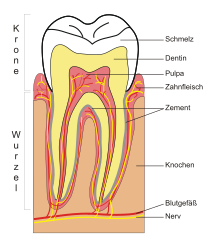Root cement
The cement ( Latin cementum , more rarely substantia ossea dentis ) is a component of the tooth that rests on the dentin in the tooth root area . It is part of the periodontal support system and consists of 65% minerals (especially hydroxyapatite ), 23% an organic part - mineralized collagen fibers and cementocytes - and 12% water . The basic substance of the dental cement thus resembles that of the fiber bone .
Root cement is permeable, yellow in color, and is softer than dentin, but as hard as bone. The root cement is used to anchor the Sharpey fibers of the tooth holding apparatus.
to form
Root cement comes in four forms:
- Acellular-afibilar: enamel surface ("cement islands", "cement tongues")
- Acellular foreign fiber cement (AFZ): in the cervical (cervical) and central third of the root, only here are the Sharpey fibers attached ("anchoring cement")
- Cellular own fiber cement (ZEZ): "Repair cement"
- Cellular mixed fiber cement (ZGZ): in the middle, mainly apical third of the root and interradicular; Layers of ZEZ and AFZ on top of each other
Like dentine, cement is formed throughout its life by cementoblasts . Cement that is formed after tooth development is also known as secondary cement.
The contact of the external basal lamina of the marginal epithelium with intact dental cement prevents an apically directed proliferation of the marginal epithelium . Acellular cement is only formed until a tooth has completed its root growth. Vital cementoblasts, together with the cells of the periodontal bone, protect the root surface from dissolution by the osteoclasts of the alveolar bone .
Web links
Individual evidence
- ^ Arnold Hohmann, Werner Hielscher: Dental technology in questions and answers: questions about anatomy, prosthetics, orthodontics and materials science . Neuer Merkur GmbH, 1994, ISBN 978-3-921280-93-5 , p. 26-27 ( google.com ).
- ↑ a b Eckhart Buddecke, Biochemical Basics of Dentistry , 1981, Walter de Gruyter, ISBN 978-3-11-008738-3 , p. 72 ff.
